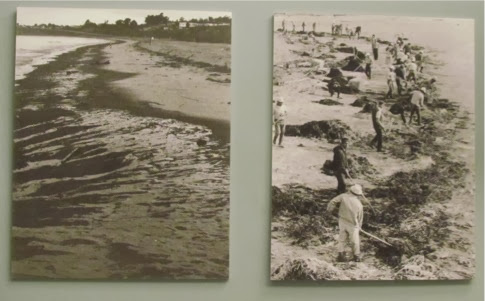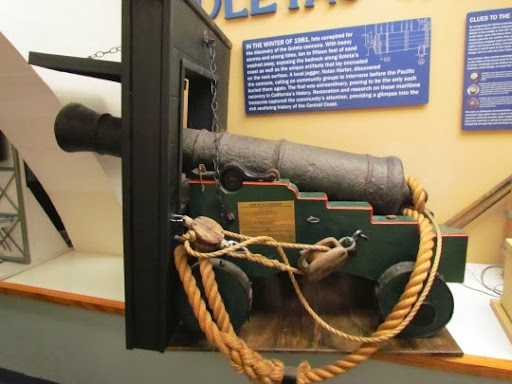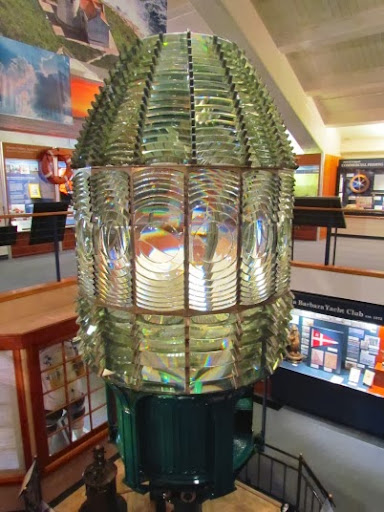Ah, the heavy rain has finally subsided, a light rain has taken its place and we’re out of here. 2 days in a small tin box and it’s time for an adventure. We’re off for the Santa Barbara Maritime Museum and a few errands. We hope we can get our daily walk in also. A full day.
As we drove in we were listening to HLN news on our Sirius - the way we are getting our news these days - and heard a story about a wave breaking the window of a restaurant in Santa Barbara. Wow, we knew that the surf and tide were supposed to be high during the storms that we’ve had the last few days, but this restaurant is on a tall wharf. How could the tide be that high? I’m sure we’ll find out.
We got to the museum about 10:00 when it opened but were surprised to see so many people milling around the area. I will admit that it is a tourist area with several shoppes and restaurants and it is also a marina with all the attendant stores like chandleries, yacht sales offices, small grocery stores and several shops which sold fresh fish - right out of the ocean. But, there were more people than that and then we noticed that there was a lot of sand where there probably wasn’t supposed to be. Sure enough, the surf had been high along with the tide and sand, kelp, driftwood and other sea things were all over the area in front of the shoppes. A yacht club parking lot had flooded, they had very hurriedly built a sand dike to protect it further but we don’t know how much damage was done, if any.

The museum was amazing. I had not expected something this informative, complete and this good. They covered not just the maritime history of Santa Barbara, they also had sections on: whaling, the seagoing Chumash, Santa Barbara’s ocean trade, pleasure yachts and racing yachts, Point Conception and its light house keepers, disasters at sea around Santa Barbara, a section on the oil platforms off the harbor, pollution, preservation of the environment and lots of model ships. There was also a large theater with movies playing constantly throughout the day.
There was a working periscope which I looked through and was amazed to see that I was actually looking out at the Pacific Ocean. I could see the oil rigs on the horizon, people walking along the beach and several boats out on the water. Wow.
We missed a film about Sir Francis Drake, one about a journey by James Cameron back to the Titanic, and two others but we did see a marvelous film about Shackelton’s Antarctic Adventure. The film was incredible, mixing actual photos and movies from the trek itself with actors portraying the story. But, the adventure itself was even more incredible. I’ll admit that I didn’t know much about Shackleton and his attempt to cross the Antarctic but now I do and am in awe of what he and his men endured for nearly 2 years.
Here is a model of an oil platform showing how much of the platform is below the ocean’s floor. And, this is only part of the story since the legs of the platform must be drilled into the floor of the ocean. The rig is 120’ above the water and 700’ under the water line. This particular rig has 24 anchor legs, each driven 200’ into the sea floor, enough so that the rig can withstand 25’ waves and earthquakes of 8 on the Richter scale.

On the other hand here are two pictures from the oil spill which occurred off the Santa Barbara shore in 1969. It was the largest oil spill in the US at the time and now ranks 3rd. It happened 6 miles off the coast and within a 10-day period 80,000 - 100,000 barrels of oil spilled into the Channel and onto Santa Barbara beaches. It killed thousands of sea birds, seals and sea lions and resulted in legislation regulating the oil industry.

Then there was the jogger, Nolan Harter, who was running along the beach after some heavy storms and winds had washed away 10’ - 15’ of sand and found some cannons just sticking up. After a long process, they have been cleaned up. No one is sure what ship they might have come from but they do date from the 1800’s.

We learned about the breakwater that Fleischmann of Fleischmann Margarine fame wanted built right where he wanted it built to form a harbor for his yacht. There were other places that would be better to put it but he donated the most money to the project and he got it where he wanted it. However, because of its placement, the movement of the sands in the small bay were disrupted and they are continually flowing into the harbor and filling the channel for the marina. Obviously, the harbor is continually being dredged now.
We learned about many of the ships which have wrecked off the coast. Point Conception, where the coast of California make a hard turn to the east is often called ‘Little Cape Horn’ for its difficulty in getting around and one of the world’s ‘graveyards’ for all the wrecks there. One of the more disastrous wrecks involved 7, count them - 7, Navy ships that got lost in the fog, turned to the East many miles before they were supposed to in rounding Point Conception and ran headlong like lemmings into the cliffs near Hondo Point, miles north of where they were supposed to be. Miraculously only 23 men were lost along with all 7 ships.
There is a section on Point Conception itself. It details the history, the Keepers and has a huge First-order Fresnal lens there. Biggest I’ve ever seen. There are even 4 steps inside the green base so the Keeper can get to the section to check the flame.

One of the Keepers, Julia Williams, took over from her husband in 1865 and became the second female keeper in CA history. In the 40 years that she was the Keeper, she only left for 3 weeks when she was ill. When she broke her hip at the age of 81, she was relieved and another woman took her place. What a woman!
Another wreck in the area was the Wilfred Scott, which ran aground on one of the Channel Islands. One of the passengers was a young man named Asa Call who went on to found Algona, IA with his brother Ambrose. My great grandparents knew the Calls and bought one of the first lots in the new town. The Call home was across the street from my grandmother in Algona and the Calls and the Smith’s were great friends.
Another section of the museum gave you an opportunity to maneuver your yacht into the harbor among all the other yachts. You got the wheel and the view in front of you and it was your turn to show your abilities. What a treat. Marvelous for kids.
All in all, an excellent museum and I’d recommend it for all.

No comments:
Post a Comment